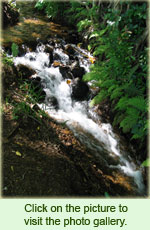
Wai, or fresh water, was an extremely important resource in earlier times as it is today. The importance of it was well understood by ka po‘e kahiko (the people of old) in that the term for rich or wealthy is waiwai. In this context, a person's wealth is determined by how much water he has access too. The reason b eing is that wai provided the people with the ability to grow crops, mainly kalo. It in essence provided life. Without wai, kalo could not have been produced in mass amounts nor would it have been able to sustain a growing population.
eing is that wai provided the people with the ability to grow crops, mainly kalo. It in essence provided life. Without wai, kalo could not have been produced in mass amounts nor would it have been able to sustain a growing population.
Like today, wai is a valuable and necessary resource for survival. Ka po‘e kahiko knew of this and established ways in which wai would be used for the benefit of all the people and not just one person. Every lo‘i farmer that lived along the same stream had equal access to the water the flowed in it. No one farmer had more claims to the water than the next. Farmers devised ways to divert just enough water from the stream for their lo‘i. The ‘auwai (irrigation) system, which was implemented traditionally and still practiced today, diverted just enough water from the stream to provide for the lo‘i. Since kalo needed a continuous flow of fresh cold water, the ‘auwai took the water back to the stream after it flowed through each lo‘i. Thus, farmers did not keep the water for themselves. They ensured that whatever water was not taken for their lo‘i was returned to the stream for the next farmer. Additionally, the water returning to the stream after it had gone through the lo‘i would do so with added nutrients, which is beneficial to fishponds that were usually built along the shorelines.